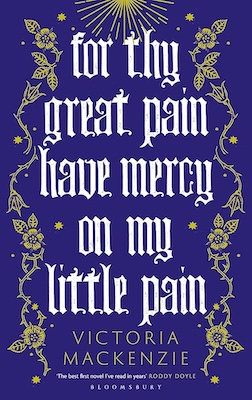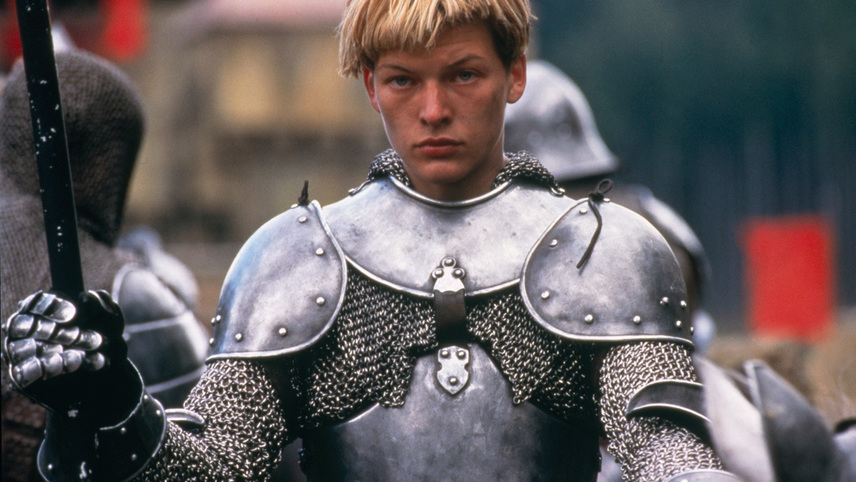Who are the women who shaped the middle ages? Can you remember? Were you ever even told about them? So many of their names are barely remembered today. Often their histories are ignored, their stories silenced or simply lost to time. Why? Maybe it’s because they were seen as dangerous. Often they were not the docile and pious creatures that we often imagine when we think of medieval Europe. No, the women who made their mark were warriors, rulers, writers, composers, artists, inventors, and so many other things besides. These dangerous women are the most fascinating of all.
My second novel, Bright I Burn, is about the loudest of ghosts: a wildly intelligent, ravenous and angry woman from history. One day out walking in the snow, I heard the voice of Alice Kyteler, the first person ever formally accused of witchcraft in Ireland in 1324. A school teacher told me about her when I was twelve, painting her as a figure from Grimm’s fairy tales, or worse an early Disney hag. I was terrified of her, but as an adult I began to realize there must be more to her than sacrificing animals and killing her four husbands. I was right. I read everything I could find about her—which wasn’t much—and discovered she was a powerful moneylender and highly influential person in the late 13th and early 14th-century. For a woman like this, it seemed highly unlikely she would have needed to practice witchcraft, and yet her trial helped lay the foundations for all the thousands of executions and murders that followed in Europe and later in the U.S. Instead of focusing on her trial, which was only a small part of her long life, I explored her four marriages, and all the jealousy, greed and passion that bred from them. The more I immersed myself in the wild and violent world of medieval Kilkenny, the more alive Alice became on the page. Often I really felt as if it was her writing, not me, and when I glance over the pages now, many came to me intact, as if in a dream.
In Ireland, Alice Kyteler is for the most part remembered through the misogynistic lens of the man who brought her case to trial. This was her legacy, and I sensed her rage about it. Her voice in my head grew louder and louder, until I sat down to write her story from her point of view. Bright I Burn is the result. It is, I hope, her legacy now.
In short this ghost of mine was formidable. What you might call ‘badass’. When I chose this term, I was thinking of a tough, uncompromising, perhaps even intimidating person. These are characteristics often associated with the men who populate the history books. The men remembered in history are often expected to be violent, even praised for it. The same cannot be said for women. Has Napoleon or Julius Caesar ever been described as badasses? I don’t think so. It’s only applied to women. Perhaps the term is meant to degrade women who display supposedly male characteristics. But the time has come to reclaim it.
So many women’s histories have been ignored or silenced. But no more. I’ve curated a small list of fiction and non-fiction books about “badass” medieval women, so that you too, if you wish, can experience the middle ages through the eyes and ears and hearts and minds of women. Let’s remember these women, not as faultless, but complicated and messy, terrifying and clever, brilliant and badass.
Matrix by Lauren Groff
A novel that beats to its own drum, Matrix is a soaring and luminous exploration of the life of a real woman from 12th-century Marie de France. There’s little known about her beyond her extraordinary writing, but the cavernous gaps in our understanding of who this woman was has allowed Lauren Groff to step in and re-imagine her. In the opening pages, Groff’s Marie de France is a queer, fierce warrior riding a warhorse. Most of the story takes place in a nunnery, but this is probably unlike any you’ve ever read about. Marie teaches the nuns she leads sword fighting and sets a bold new course to find wealth and power. Most compelling about Marie is not her resilience or strength, but her determination to make her mark on a man’s world, and which she achieved with her writing. But it is Groff’s skill with the pen that really shines throughout the book. Every page is spangled in a way that feels uniquely medieval. I defy you, reader, not to fall in love with this flawed, fierce, and completely brilliant woman that is Lauren Groff’s Marie de France.
Femina: A New History of the Middle Ages, Through the Women Written Out of It by Janina Ramirez
‘I am the fiery life of divine substance, I blaze above the beauty of the fields, I shine in the waters, I burn in sun, moon and stars.’—Hildegard of Bingen
The pitch for this one really is in the title. Janina Ramirex highlights, in rare technicolor for a work of history non-fiction, many of the key women figures in medieval Europe: leaders, artists, scientists, spies, diplomats, entrepreneurs and outcasts. Reading this book will most likely fill you with a riotous rage that you’ve never heard of any of these brilliant women before. Ramirez explores all their wild and fascinating lives, but more importantly how they shaped the world we live in now. One brilliant example is Ramirez’s account of Hildegard of Bingen (1098 – 1179) who was a German Benedictine abbess and polymath active as a writer, composer, philosopher, mystic, visionary, and medical practitioner. Hildegard was also influential across Europe, giving counsel to all kinds of people including popes and kings. She is just one tantalizing example of the types of women you will find hidden within these pages. Yes, this is a history book, a widely and deeply researched one, but please don’t let this dissuade you. It is is vastly readable and enjoyable.
Hild by Nicola Griffith
‘When fools are in charge, wise men make no predictions.’—Hilda of Whitby
Sometimes, we want to lose ourselves in a thick, luxuriously long novel, and this meticulously crafted tapestry of 7th-century England is ideal if you’re looking for deep immersion in the past. Hild thrusts the reader into the early life of Hilda of Whitby, a woman who would come to be worshipped as a saint. She is destined to become the king’s seer, but her true skill is in observation of people and nature. Most wonderful about this reimagining is that Hild is bisexual. Ideas about sexuality were not as rigid in the middle ages as we might expect and Griffith leans into this with beauty. Every facet of medieval England is brought to life from the domestic to the bloody, reminding us just how privileged we are to live in a world where we can easily heat our homes or phone our loved ones. From the first to last page, the reader is completely transported to the 7th century. It really is a feast of a book.
She-Wolves: The Women Who Ruled England by Helen Castor
In medieval England, men ruled women, and the King was ruler of everyone. Yet, royal power ended up in the hands of women. Of course, not all historians agree with this delicious and convincing reading of the past by Helen Castor, but we shan’t concern ourselves with them. In She-Wolves Castor tells the dramatic histories of four women who wielded great power: Matilda, Eleanor of Aquitaine, Isabella of France and Margaret of Anjou. Castor fleshes out the lives of these four who have, with the exception of Eleanor of Auiquitaine, were overlooked in history books because they were wives, and their husbands, the kings, were considered to be more important than them. Castor maps out how each of these women shaped the England that followed, laying the way for Mary Tudor and Elizabeth I to become sole ruler of England. Throughout the book, the writing is fluid and full of verve. It is clear in every sentence what pleasure Castor takes in the written word, illustrating that beautiful sentences are created not only by novelists. I predict you will be won over by the she-wolves, and Castor too.

For Thy Great Pain Have Mercy on My Little Pain by Victoria MacKenzie
‘I take no heed what you have been but what you would be.’—Margery Kempe
A small but mighty epic, For Thy Great Pain Have Mercy on My Little Pain shows us that historical fiction can be just as potent, even when the writing is lean, and the details of the past sparse. Yet due to this every sentence feels layered and weighty. MacKenzie explores two fascinating women who lived in the 14th century: Margery Kempe and Julian of Norwich. Although very different women who lived almost opposite lives, one as a religious recluse, and the other as a wife with fourteen children, they both had visions which they interpreted as being gifted by God. This counterpoint between the two builds until the final pages where they finally meet, reflected in MacKenzie’s experimental and at-times fragmented writing style. This is a book that can be read over and over and new meanings and nuances will be found each time.
Kristin Lavransdatter, I: The Wreath by Sigrid Undset, translated by Tiina Nunnally
It is challenging to find book set in the middle ages that don’t focus on England or France, but The Wreath by Sigrid Undset is a rare exception. Set in 14th-century Norway, it is about a fictitious Norwegian woman, Kristin Lavransdatter, who is defiant in her behavior yet often ridden with guilt, unsurprising given the religious zealousness of this period. Kristin falls in love, or at least in severe infatuation, with Erlend, a ravishing and rich rake. Kristin is the only character from this list of books who is entirely fictitious, however, Undset brings her to life with a vividness that convinces us readers that perhaps, just perhaps, she did live. At the very least we leave the book feeling that women like her must have existed. The meticulous research shimmers on every page, but the writing is in no way labored by it. This is the key to truly skilled historical fiction, and no doubt a major contributor to Sigrid Undset winning the Nobel Prize for Literature in 1928.
Joan by Katherine J. Chen
“One life is all we have and we live it as we believe in living it.”
Joan of Arc is probably the most famous medieval woman so it’s not surprising that there are many novels about her, but a recent stand out is Katherine J Chen’s Joan. There is a freshness and also a sheer sense of excitement in almost every line of this book. This is a Joan that feels new. Chen introduces us not to a supremely pious girl visited by visions from God, but to a girl with physical gifts. She is strong and agile, which makes sense for a girl who would go on to lead the French to victory against the English, yet usually there is a frailty or even mania to the portrayals of Joan. Chen’s inhabitation of the character is far more realist and because of that far more alive. It is a surprisingly propulsive read given that most of us know the story, and know her ending. Yet this book makes us question history’s portrayal of Joan, and consider that she may have been different to how the mostly male historians have written her. This is one of the powers of historical fiction: the best writers can shine a light on the misogyny of our beliefs about the past. Chen does this in flaming, and illuminative language, recasting this woman as far more complex than we had imagined.
Read the original article here

